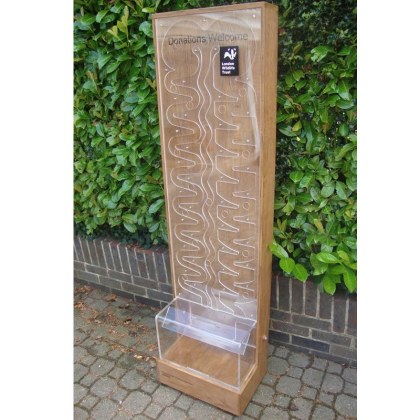Tip Jar Ideas, Laws and Best Practices
Tip jars are a way for customers to show their gratitude and appreciation for an excellent service. They’re usually a small glass or tin found close to the till, with a funny message or drawing attached to attract customers’ attention.
This blog covers the basics on how to create a successful tip jar, shares some funny and creative tip jar ideas, and covers some of the laws and general guidelines around tips and gratuities.
How to create a successful tip jar
A good tip jar should be eye catching, but not in-your-face. It’s quite distasteful to display a message that directly demands tips, or outright asks for extra money. Instead, opt for a tip jar design that encourages people, appealing to their generous side, framing tips more as a token of appreciation rather than a prerequisite.

Jar type
A tip jar doesn’t necessarily have to be a boring glass jar. Get creative, and think of a more uncommon jar type that people will want to interact with.
You could try using a roll-a-coin, or coinspinner like the one pictured above, for a more interactive tipping service for customers. [image]
Another fun container idea is a coin drop, where customers can watch their coin fall through a maze of pins and other obstacles. [image]
Or, why not dress your tip jar up as a tradition, red UK post box, or use a piggy bank? If you’re less interested in directly asking for a donation but would rather use a tip jar that’s entertaining and eye-catching, focus more on the vessel itself. Make sure to label your tip jar correctly though, in case people mistake it for a charity box.

Battles
There are two things that people love: some healthy competition, and sharing their opinions. The ‘battle’ tip jar appeals to both of these things. Create a tip jar that is divided into two sides, and asks for an opinion, or encourages sides to compete. You might choose to ask a controversial question, but keeping things light-hearted is best. Some ideas:
- Peace on Earth or piece of cake?
- Who is better? Android users or iPhone users?
- Which would you rather have - never ending coffee or never ending beer?
Ask without asking
You can still create a funny tip jar without directly asking for change. Use charm, or a silly play on words to appeal to your customer’s generous side.
“Help buy your server a haircut”, “College fund”, and “Beer money” are harmless labels that might reach your customer’s soft spot and encourage them to round up their bill.
Try the money rating scale:
- “On a scale of $1 – $10... How attractive are you?”
- “How nice was your meal”?
You could also play it simple, and make a money joke. ‘Fear of Change’ jars are quite popular. The common phrase doubles as the perfect money pun, since quite a lot of people do, in fact, hate carrying around loose change. Write something like: “If you have a fear of change, why don’t you leave it here?”
Or, “Money is the root of all evil. Cleanse yourself here!”
Do your visitors a favor and help them get on the right path by leaving their money with you.
Global laws around tips and gratuities
Once you’ve read our guide on how to get more tips when working as a server and created your perfect tip jar, you’ll have to understand the laws and norms around tipping. Tipping is a hot topic around the world, since tipping practices vary a lot between different cultures and countries.
Ireland and the UK
In the UK and Ireland, there aren’t a lot of hard-fast rules about tipping, other than the law that service charges, tips, gratuities and cover charges cannot be used to make up national minimum wage pay.
All workers must receive the minimum wage set by the government, and tips and gratuities serve as extras. Since service charges must, by law, be displayed as part of the overall cost displayed at the venue, it’s up to the employer or business owner what they do with this money. Employers do, however, have to declare any tips and extra payments to the government, but they are not legally bound to disclose this to their employees [1][2].
Both Ireland and the UK have suggested Codes of Best Practice when it comes to tips and gratuities, but ultimately it’s up to the employer to handle how it’s distributed.
Australia and New Zealand
As with the UK and Ireland, it’s legally required to display the final price including tax and service charges on the menu or rates card. Employers must also pay a livable minimum wage to service staff, that is separate to tips and gratuities [3]. In both Australia and New Zealand, there is no law to determine who owns tip money - employee or employer.
Tips have the legal status of a gift. Therefore, it depends on who the customer says they’d like the tip to go to. The problem arises with anonymous tips, like those in tip jars, when customers don’t announce who they’d like the money to go to. In this case it’s most commonly assumed that the customer objectively intends to give the tip to the business as to employees [4].
Most often, tips aren’t expected in Australia and New Zealand. In fact, in New Zealand in particular, people are quite opposed to tipping, and in some cases try to discourage others since service staff are paid a separate wage [5].
US
The social custom of tipping began in America, and many people still associate the idea of paying a tip with America today. Initially, the concept was met with mixed responses, and were in fact illegal in some states in 1915, as they were viewed as “commercial bribes,” or tips for the purpose of influencing service [6].
The current US federal law hasn’t changed a lot since 1938, where employers were only required to pay tipped workers a wage that would add up to the federal minimum wage when combined with tips. Today, the federal minimum wage for tipped workers is $2.13. The main federal minimum wage is $7.25. Only seven states mandate that all workers, regardless of tips, must be paid the “full state minimum wage before tips,” according to the U.S. Department of Labor [7].
A gratuity of 15 to 20 per cent on top of the bill (before sales tax) is standard. Since the service charge isn’t usually included in the advertised price, the tip is generally viewed as the server’s property, rather than the employers.
Canada
When it comes to tipping in Canada, the business owner and managers cannot legally take or retain tips earned by their employees, or use tips to make up their wage. Known as the Protecting Employees’ Tips Act, Ontario have an act that dictates that employers cannot withhold gratuity or deduct tips from their employees [8]. Tips are viewed in two categories: controlled tips and direct tips.
The term controlled tips refers to tips that an employer controls or possesses and then must pay to the employee. Some examples of controlled tips:
- The employer adds a mandatory service charge to a client's bill to cover charges.
- The employer adds a percentage to a client's bill to cover tips.
- Tips that are allocated to employees using a tip-sharing formula determined by the employer.
Direct tips are paid directly by the customer to the employee. The employer has no control over the tip amount or its distribution. The following are some examples of direct tips:
- A customer leaves money on the table at the end of the meal and the server keeps the whole amount
- A guest gives a tip directly to the service person they want to keep it.
- The employees and not the employer decides how the tips are pooled or shared among employees [9].
Track customer payments with Epos Now
Your customers’ meal should be a completely seamless process, and that includes preparing the bill. To maintain that atmosphere of seamless service, you need to master your restaurant POS system.
A restaurant’s point of sale (POS) system doesn’t just have to be a machine for tabulating prices and bills. It can be an inventory tracking system, a floor plan management tool, or a customer loyalty tracker. With the right POS system, you can do so much during your service that will help you streamline your operations. Doing this will help you make your operations more efficient, providing better service, and, as a result, be a magnet for huge tips.
With an Epos Now Hospitality POS system, you can:
- Track time-at-table and manage floor plans in real-time to boost table turnover.
- Eliminate costly errors with automated ordering and effortless communication.
- Group by course and order type to speed up preparation and reduce customer wait times.
- Inside, outside, or curbside: take orders from anywhere to speed up service.
- Maximize upsell opportunities by freeing up your waiting staff to spend more time with guests.
- Speed up service and increase covers with fast, hassle-free service.
- Increase accuracy, and ensure that your customers get exactly what they want. On-time, every time.
Contact Epos Now to find out more about our systems and services




